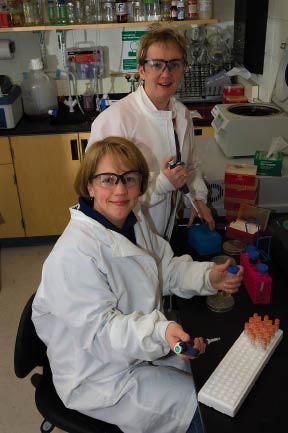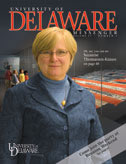Seafood pathogen poses growing danger

RESEARCH | A microorganism that lives in seawater and is a leading cause of seafood-borne illness worldwide is expanding its range and virulence, and a new research study at UD is seeking to learn why.
Illness caused by Vibrio parahaemolyticus, which is related to the bacterium that causes cholera, is most frequently associated with the consumption of raw or undercooked seafood, particularly oysters, other mollusks and crabs. Victims typically suffer from diarrhea, vomiting, fever and chills for a few days, although the infection can be fatal in those with weakened immune systems.
“This organism has been around for a long time,” says Michelle Parent, assistant professor of medical technology in the College of Health Sciences and a co-investigator on the study. “However, only recently, in the past decade, has a new, more virulent isolate become more prevalent around the globe.”
In North America, Vibrio parahaemolyticus is considered an “emerging pathogen.” An estimated 4,500 cases of infection occur each year in the United States, according to the Centers for Disease Control, but the agency suggests the number likely is much higher because cases go unreported. In addition, the aquaculture industry loses millions of dollars each year due to the contamination of oyster beds.
“This organism grows super-fast. It has a replication time of six to nine minutes, which is very quick compared to other microbes,” Parent says.
The ultimate aim of the study, which is funded by a $400,000 food biosafety grant from the U.S. Department of Agriculture (USDA), is to determine how the organism overcomes its victim’s immune system.
Working with Parent on the project are E. Fidelma Boyd, assistant professor of biological sciences in the College of Arts and Sciences, and collaborator Gary Richards, a research microbiologist at the USDA’s Agricultural Research Service in Dover, Del.
“Vibrio parahaemolyticus is most prevalent in the warmer summer months, especially in the U.S. Gulf Coast region, where it occurs in high numbers,” Boyd says.
“In the past decade, the organism’s geographic distribution has been extended into more northerly climes, in particular, the Pacific Northwest, most likely due to global warming. Thus, the occurrence and prevalence of the organism is likely to continue to expand.”
An oyster filters its food from the seawater in which it lives, ingesting not only tiny plankton but also whatever else may be present in the water, including harmful bacteria such as V. parahaemolyticus. Thus, a person who consumes a raw oyster contaminated with the organism becomes infected. (Thoroughly cooking the seafood can prevent infection.)
The researchers want to determine what happens once V. parahaemolyticus attaches to a host’s cells and begins multiplying and what immune response is required to eliminate infection.
“Something is happening to allow this organism to predominate,” Parent says. “What makes it so powerful? Does it have some advantage in the environment?”
In a recent study published in BMC Microbiology, Boyd, Parent and their co-authors show, using genomic analysis, that this new virulent strain has acquired large pieces of DNA, which may give the bacterium a major advantage from an evolutionary point of view.
For more on research at the University of Delaware, visit www.udel.edu/research.
Article by Tracey Bryant





